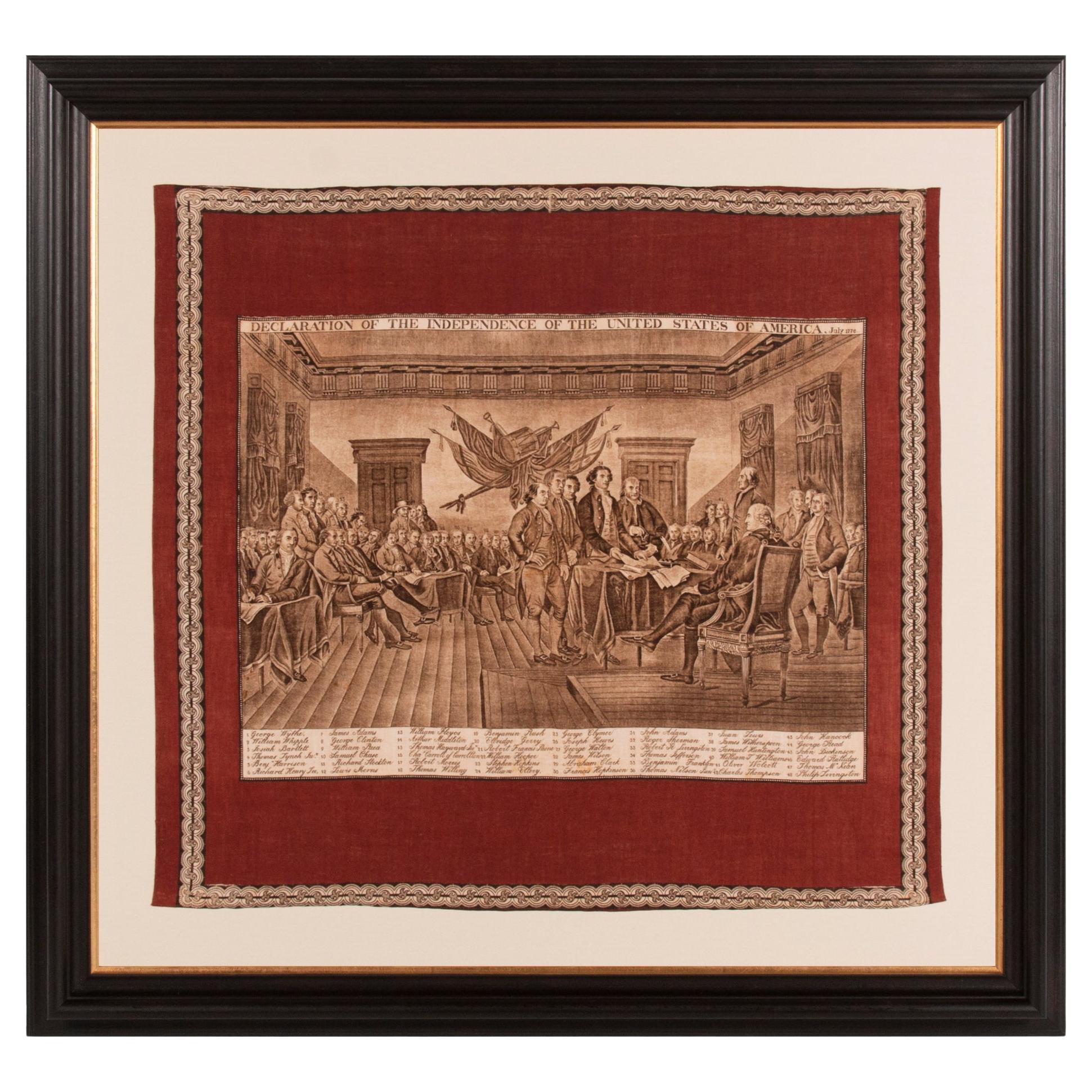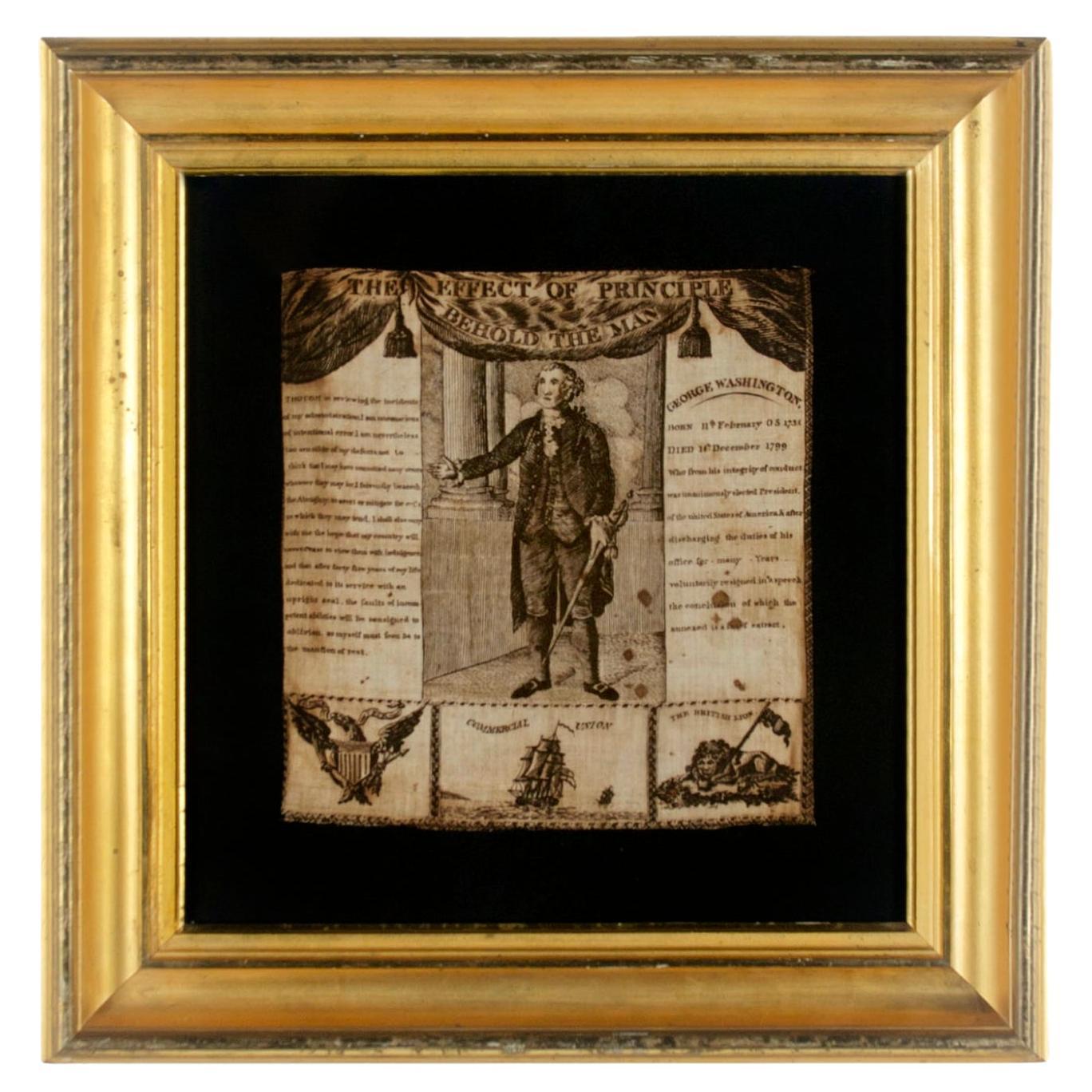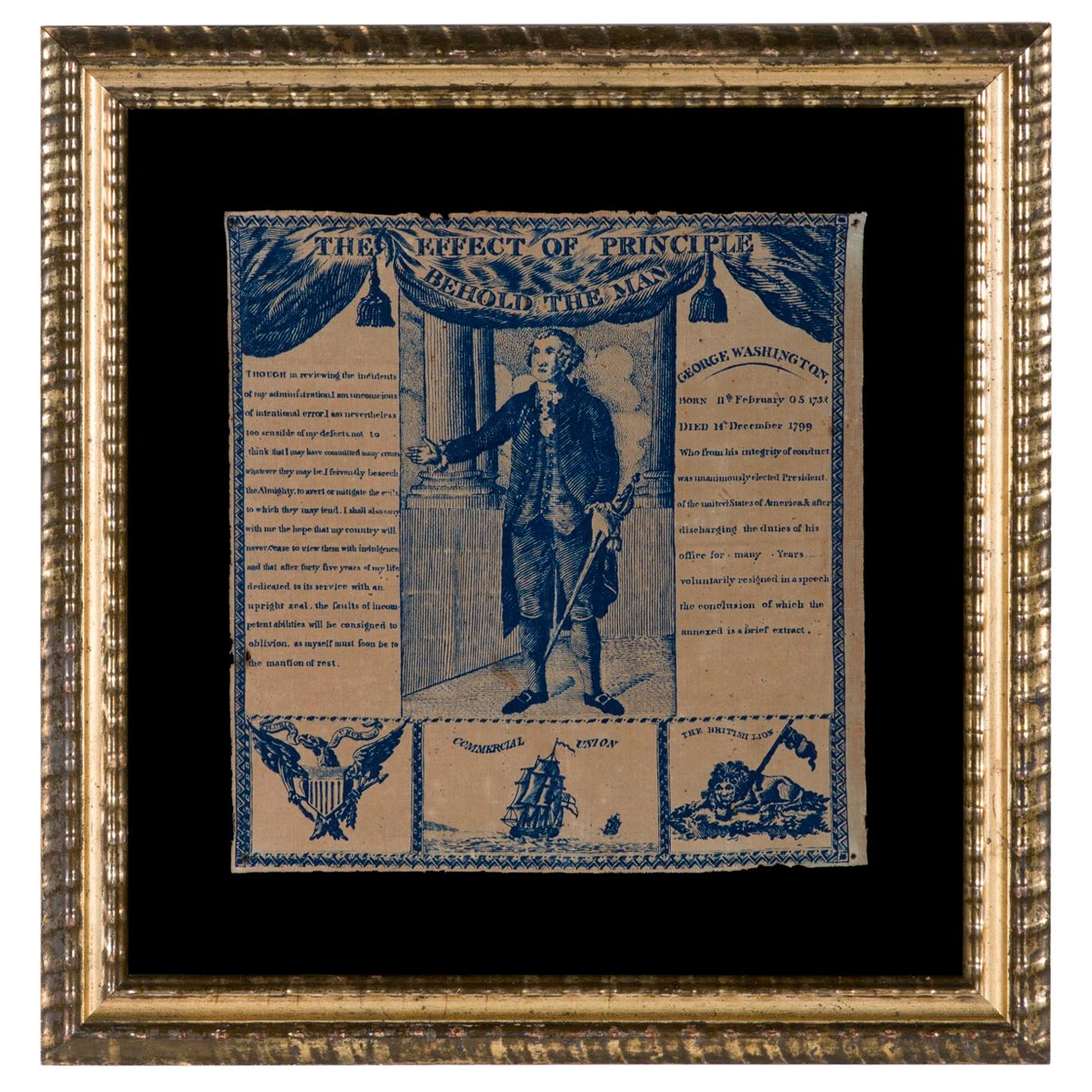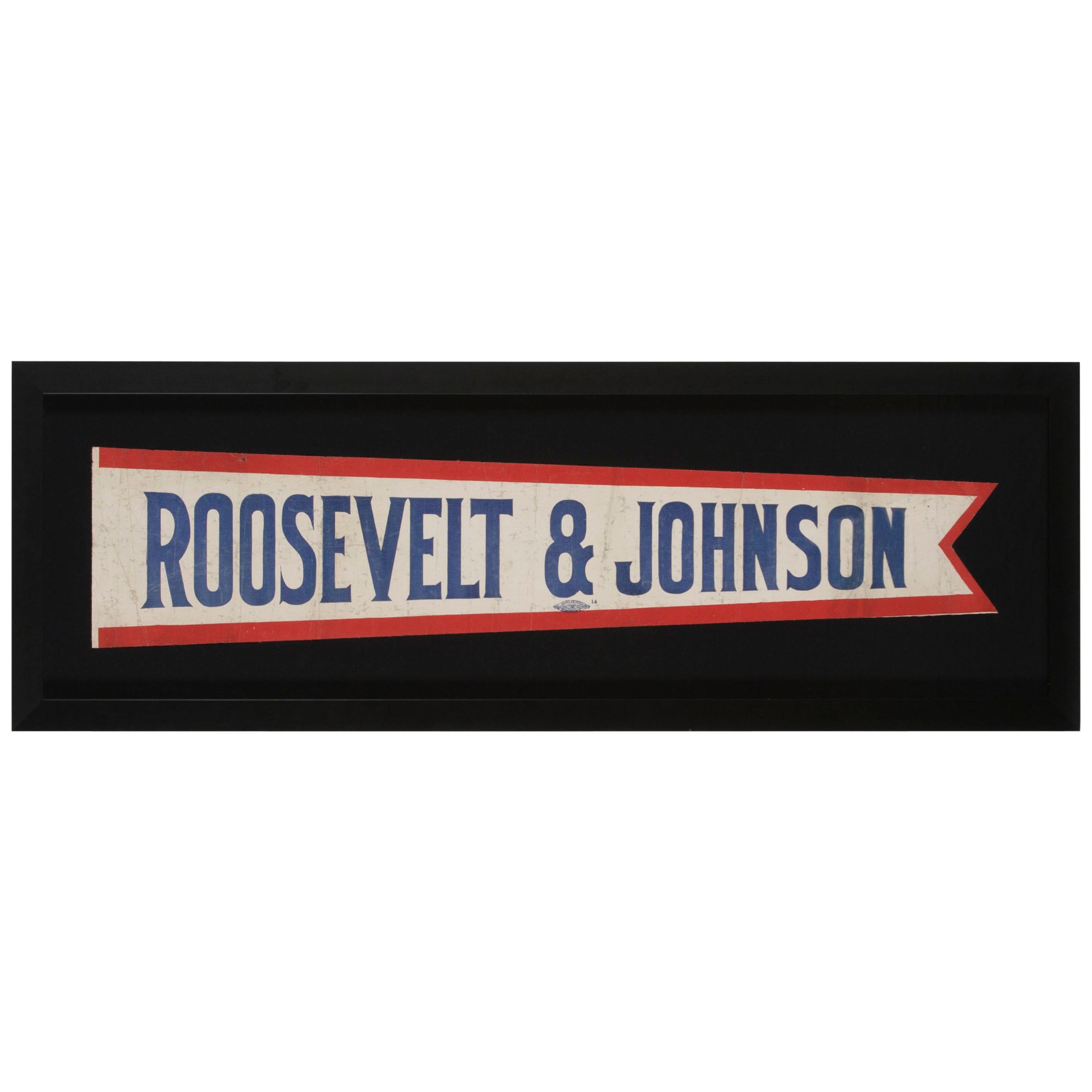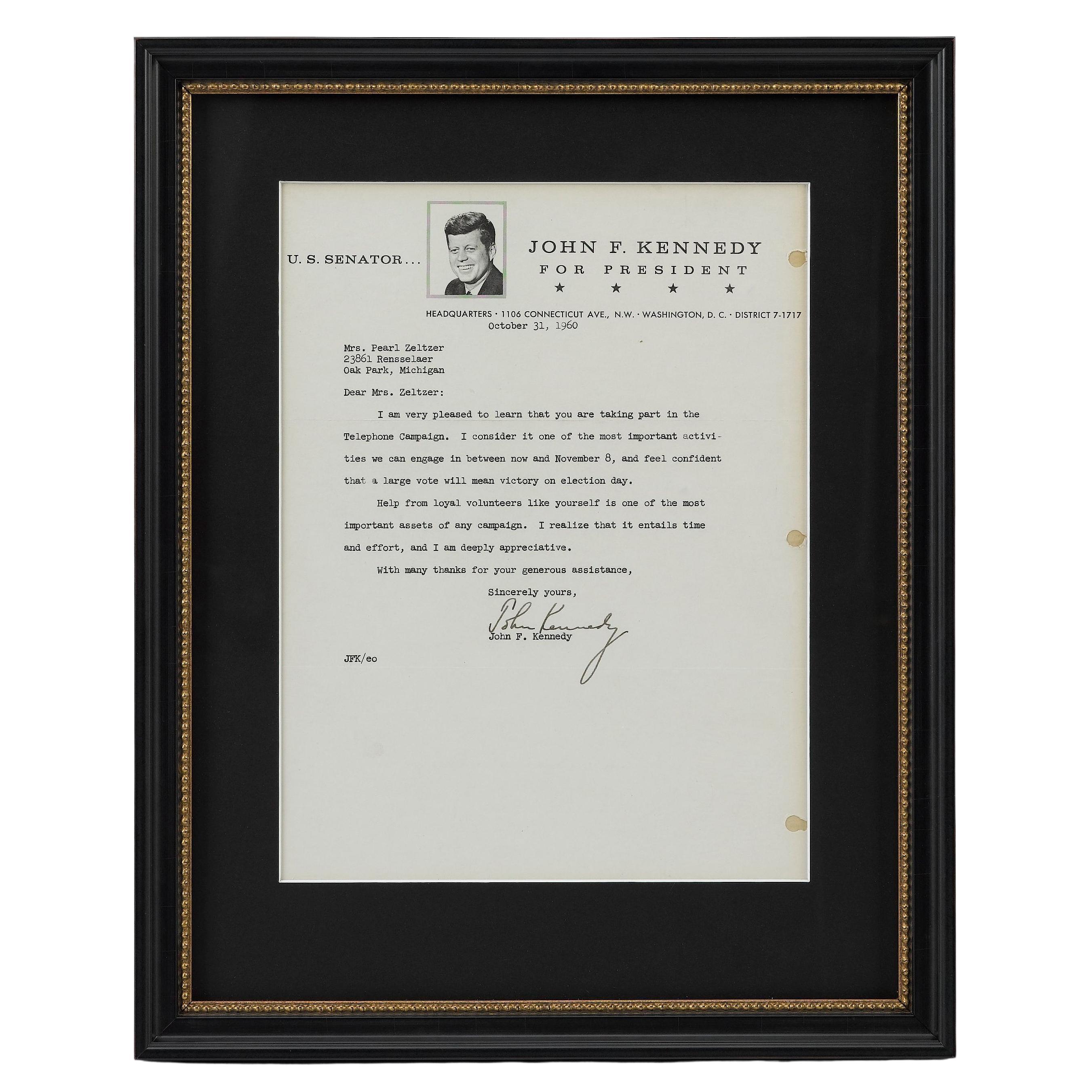Items Similar to 1840 Campaign Kerchief of William Henry Harrison on Horseback
Want more images or videos?
Request additional images or videos from the seller
1 of 7
1840 Campaign Kerchief of William Henry Harrison on Horseback
About the Item
1840 campaign kerchief featuring an image of William Henry Harrison on horseback in military garb, one of the first known campaign textiles in early America
Printed in mulberry red ink on white cotton, this kerchief's central imagery includes a sweeping portrait of our 9th President, on horseback, in full military garb with sword drawn. Set within a square window, this is framed by a fanciful wreath comprised of six circular medallions, each of which contains a different landscape. Together they paint a picture of Harrison's achievements and campaign identity. Included are his famous 1811 military victory over Shawnee Indian chief Tecumseh and a confederation of various Indian nations at the Battle of Tippecanoe. Harrison adopted this battle as a nickname, with the resulting campaign cry for “Tippecanoe and Tyler too!”
Another vignette shows Harrison leading a cavalry charge against Native American at British forces at the War of 1812 Battle of Thames in Canada. Harrison’s victory at Thames was considered pivotal in the war and second only to Andrew Jackson’s triumph at the battle of New Orleans.
There are illustrations of a landmark treaty with Northwest Indian Tribes (one of two he facilitated), and of the United States Capital, where Harrison served as both a U.S. Congressman and Senator. Also included are the iconic log cabin and hard cider barrel that became the logos of his campaign, and of Harrison posing as "the Ohio Farmer", plowing fields in North Bend.
During the course of the campaign, a Democratic editor dismissed the candidate, stating that if you gave him a $2,000 pension and a barrel of hard cider, he would spend the remainder of his days contented in a Log Cabin. Where one might have seen mud-slinging, the Whigs saw opportunity. Harrison was a member of an aristocratic Virginia family, born on a plantation, who now lived in an expansive Indiana home with 20 rooms and 13 fireplaces. His opponent, Martin Van Buren, was a New Yorker with an aristocratic air, with whom the average man could not connect. The Whigs adopted the disparaging story to create a new identity for their candidate. From here on, the rustic log cabin and hard cider barrel became symbols used to portray Harrison as a commoner.
Harrison had recently acquired property in Ohio, where he took a short-lived hand at farming. “The Farmer of North Bend” became another slogan used to mask the reality of Harrison's social circumstances.
Harrison was the first presidential candidate to advocate for his own election and the first to employ others to write campaign speeches. His kerchiefs, flags, and banners are the earliest that exist to support a politician who was actively campaigning. Designs are known with imagery or text representing two earlier presidents, Andrew Jackson and John Quincy Adams, but only one example of each may survive and the purpose of their manufacture is unclear. Political supporters and friends may have commissioned their manufacture, but nothing about their origin is presently known.
Brief Biography & Notes Regarding the 1840 Campaign
William Henry Harrison (b. Feb. 9th, 1773) was the son of wealthy plantation owner Benjamin Harrison V, who was a delegate to the second Continental Congress, a signer of the Declaration of Independence, and Governor of Virginia. William was the last president to be born as a British subject. Following his military career he became secretary of the Northwest Territory, then governor of the subsequently divided Indiana Territory, then moved to Ohio where he served as a U.S. Congressman, State Senator, and U.S. Senator.
Martin Van Buren, Harrison’s Democrat opponent, was a New Yorker and the incumbent president. Van Buren's aristocratic air, combined with economic depression that included the devastating collapse of the Second National Bank of the United States, subsequently lost him the 1840 election.
At age 68, Harrison was elected as the oldest president to date, inspiring over 80% voter turnout, but today he is best remembered for serving the shortest term in the history of the American presidency. To prove he was not elderly and feeble, he gave a record-breaking hour-and-forty-five minute inauguration speech in freezing rain. Forgetting a topcoat, he then greeted guests and remained outdoors for a prolonged period. He subsequently caught pneumonia and died just 32 days after taking office.
Vice President, John Tyler, was chosen for the ticket because he was a Southerner and thus balanced the interests of slave owners. Tyler finished out his 4-year term but was generally unsuccessful in the White House, unpopular, and did not seek reelection.
Election Results:
William Henry Harrison, Ohio (Whig) - 52.9% PV, 234 EV
Martin Van Buren, New York (D) - 46.8% PV, 60 EV
Mounting: The kerchief has been hand-stitched to 100% cotton, black in color, which was washed to reduce excess dye. An acid-free agent was added to the wash to further set the dye and the fabric was heat-treated for the same purpose. The mount was then placed in a black-painted, hand-gilded and distressed Italian molding. The glazing is U.V. protective acrylic.
Condition: There are minor stains and foxing, but the condition is extraordinary, especially for the period.
- Dimensions:Height: 37 in (93.98 cm)Width: 38.25 in (97.16 cm)Depth: 2.5 in (6.35 cm)
- Materials and Techniques:
- Place of Origin:
- Period:
- Date of Manufacture:1840
- Condition:See Item Description.
- Seller Location:York County, PA
- Reference Number:
About the Seller
5.0
Recognized Seller
These prestigious sellers are industry leaders and represent the highest echelon for item quality and design.
Established in 1991
1stDibs seller since 2008
61 sales on 1stDibs
Typical response time: 10 hours
- ShippingRetrieving quote...Ships From: York County, PA
- Return PolicyThis item cannot be returned.
More From This SellerView All
- Large Scale Printed Kerchief of the Signing of the Declaration of IndependenceLocated in York County, PARare, large scale Kerchief with a beautifully engraved image of John Trumbull’s “declaration of independence,” likely made in...Category
Antique Mid-19th Century American Political and Patriotic Memorabilia
MaterialsCotton
- Printed Linen Kerchief of George Washington, ca 1806, Germantown, PALocated in York County, PAExtraordinarily early (1806) printed linen kerchief glorifying George Washington, Germantown print works, Germantown, Pennsylvania Printed in sepia ink on coarse, white linen, this patriotic kerchief shows a standing portrait of George Washington, above which is a swag valance and the words “The Effect of Principle, Behold the Man”. The portrait is based on a mezzotint after Gilbert Stuart’s very famous painting of Washington in his later years. Stuart painted it in oil on canvas for a wealthy merchant by the name of William Constable, who commissioned the work for Alexander Hamilton. The kerchief is interesting because it is both American-made and documented. This is exceptionally unusual for any printed textile of the 19th century or prior and the earlier the time period the more unlikely an object is to be identified. This kerchief and a companion piece entitled “The Love of Truth Mark the Boy” (also glorifying Washington through the fabled story of the cherry tree), were made ca 1806 by Germantown Print Works in Germantown, Pennsylvania. To the left of Washington's image is a portion of his infamous farewell address to his troops at the end of the Revolutionary War. To the right is a short excerpt from his eulogy. Below these are three images. In the center is a square-rigged tall ship with “Commercial Union” above it, flanked by the American eagle on the left and the British lion...Category
Antique Early 19th Century American Political and Patriotic Memorabilia
MaterialsLinen
- Patriotic Silk Kerchief w/ 34 Star Flags & an Image of Washington, Civil War EraLocated in York County, PAPATRIOTIC SILK KERCHIEF OF THE CIVIL WAR PERIOD, WITH AN ENGRAVED IMAGE OF GEORGE WASHINGTON, CROSSED 34 STAR FLAGS, AN EAGLE, AND "UNION FOREVER" SLOGAN: Patriotic kerchiefs that date prior to the 1876 Centennial of American Independence are rare among surviving 19th century textiles. Printed on silk and made during the opening years of the Civil War, this example consists of a white ground with red and blue borders. Inside is a prominent, copper engraved, device that consists of a large image of George Washington, crowned by a spread winged eagle that grasps a billowing streamer in its beak and talons. The ribbon boasts the Federal sentiment "Union Forever." The likeness of Washington is derived from Gilbert Stuart's Athenaeum portrait. Below this is a facsimile of Washington's signature, cradled by crossed American flags, each with 34 stars arranged in circular medallions. Although political textile historian Herbert Ridgway Collins associated this kerchief with the centennial of American independence,* there is overwhelming evidence that it was produced earlier. The large scale is much more indicative of kerchiefs produced in the 1860's and prior. Made of silk, the binding is hand-stitched, which is also common of those produced before 1876. When these facts are added to the pro-Union Civil War slogan and flags in the 34 star count, the combination of all these factors points firmly to Civil War period manufacture. Kansas was admitted into the Union as the 34th state on January 29th, 1861, about two-and-a-half months before the Confederate assault on Fort Sumter that marked the beginning of the Civil War. The 34th star was officially added on July 4th of that year and the star count remained official until July 4th, 1863. Further evidence can be found in an example of this kerchief that resides in the collection of the Adams County, Pennsylvania Historical Society, with firm provenance to a woman by the name of Emma Yount. The story goes like this: “With the Battle of Gettysburg looming and the countryside in turmoil, the Union cavalry rode into Gettysburg on the afternoon of June 30, 1863. The troopers dismounted and lounged in the town while awaiting further orders. During that time, the seven year old daughter of innkeeper Israel Yount, Emma, was playing outside their home when a cavalryman asked her to come and visit with him while he was resting. The cavalryman told her that he missed his young daughter at home and asked if little Emma would hug and kiss him on the cheek to remind him of his daughter, who he felt he might not ever see again. Emma asked her mother if she could do as the cavalryman suggested, and her mother considered the circumstances and allowed Emma to do so. Before leaving, the cavalryman gave young Emma a silk handkerchief he was carrying that featured George Washington's image and patriotic border and flags. Emma kept that handkerchief until her death in 1946 and it was then donated to the Adams County Historical Society.” The trio of brass rings, hand-sewn along the top edge, would have been added by a former owner so that it could be hung vertically. The textile itself is both beautiful in design and rare. Outside of an example pictured by Collins in his book “Threads of History” (Smithsonian Press, 1979), and the copy in the Adams County Historical Society, only three others like it are known to have surfaced, including this example. This condition is excellent for the period and it survives as an exceptional relic of the War Between the States. It is of interest to note that kerchief bears marked similarities to another, especially rare, pro-Union variety, that was produced in London for the American market. Notably larger in scale, but very much alike in terms of the fabric, the printing, the shades of red and blue, the verbiage, and the general overall graphic feel, it was produced by Foster & Porter, a known, English maker of printed kerchiefs. Instead of featuring George Washington, the imagery centers on a large cannon...Category
Antique 1860s American Political and Patriotic Memorabilia
MaterialsSilk
- 1806 Printed Linen Kerchief Glorifying George Washington, Germantown, PennLocated in York County, PAEXTRAORDINARILY EARLY (1806) PRINTED LINEN KERCHIEF GLORIFYING GEORGE WASHINGTON, PRINT WORKS, GERMANTOWN, PENNSYLVANIA Printed in blue ink on coarse, white linen, this patriotic kerchief shows a standing portrait of George Washington, above which is a swag valance and the words “The Effect of Principle, Behold the Man”. The portrait is based on a mezzotint after Gilbert Stuart’s very famous painting of Washington in his later years, most often referred to as the Landsdowne portrait. Stuart painted three versions of it in oil on canvas, one of which was completed in 1796 for a wealthy merchant by the name of William Constable, who commissioned the work for Alexander Hamilton. The kerchief is interesting because it is both American-made and documented. This is exceptionally unusual for any printed textile of the 19th century or prior and the earlier the time period the more unlikely an object is to be identified. This kerchief and a companion piece entitled “The Love of Truth Mark the Boy” (also glorifying Washington, through the fabled story of the cherry tree), were made circa 1806 by Germantown Print Works in Germantown, Pennsylvania. To the left of Washington's image is a portion of his infamous farewell address to his troops at the end of the Revolutionary War. To the right is a short excerpt from his eulogy. Below these are three images. In the center is a square-rigged tall ship with “Commercial Union” above it, flanked by the American eagle on the left and the British lion on the right. It is reasonable to assume that the textile may have been produced in demonstration of the maker's desire, and/or that of others, to advance trade with England. Commercial printers were very influential in early America, as they possessed the means by which to disseminate information. This kerchief and its companion piece are documented in Threads of History, Americana Recorded on Cloth, 1775 - the Present, by Herbert Ridgeway Collins (1979, Smithsonian Press), p. 63, items 38 & 39.* The two pieces pictured are in the collection of Cornell University, but the Collins text also cites an uncut pair to be present in the collection of the Western Reserve Historical Society, Cleveland, OH. The name "Germantown Print Works" is printed on the Western Reserve examples. Another example of the textile in question is documented in "Running for President, The Candidates and Their Images, 1789-1896" by Schlesinger, Israel, and Frendt, (1994, Simon & Schuster), p. 15. I have seen three different color variations of this textile, including sepia, mulberry red, and blue. This particular example has a hand-sewn binding along the top, lower, and left edges. Mounting: The textile was mounted and framed within our own conservation department, which is led by expert staff. We take great care in the mounting and preservation of flags and have framed thousands of examples. The gilded molding has a rippled profile and dates to the period between 1825 and 1850.The background is 100% cotton twill, black in color. The glazing is U.V. protective plexiglass. Feel free to contact us for more details. Condition: There is an all-over golden oxidation of the white fabric and there is very minor staining. There are tiny tack holes in each corner and there are minor nicks around the perimeter. * Collins relates that Germantown Printworks was operated by the Hewsons. In doing so he cites one of Worthington Chauncey Ford's books on George Washington, but it isn't clear which one (there are many) and no page numbers are given. John Hewson was an Englishman who came to America and opened his printing business on the advice of Benjamin Franklin. He was one of the first “calico printers” and is the earliest documented to have advertised printed kerchiefs. His ads for bandanas appear as early as June 20th, 1774. He is suspected of having produced the very first American kerchief that pictured an American president, which is documented in Collins as item 1 on page 48. Linda Eaton, curator at Winterthur, in 2012, is currently doing in depth research on the three printers of fabrics that were operating in Germantown in early America. She discovered that the owner and/or operator of Germantown Print Works, while not currently known, was not John Hewson. This information is not yet published. She also noted that Winterthur possessed examples of the two George Washington textiles...Category
Antique Early 1800s American Political and Patriotic Memorabilia
MaterialsCotton
- Elongated Pennant Made for the 1912 Presidential Campaign of Roosevelt & JohnsonLocated in York County, PAELONGATED PENNANT MADE FOR THE 1912 PRESIDENTIAL CAMPAIGN OF THEODORE ROOSEVELT & HIRAM JOHNSON, WHEN THEY RAN ON THE INDEPENDENT, BULL MOOSE / PROGRESSIVE PARTY TICKET: Elongated,...Category
Vintage 1910s American Political and Patriotic Memorabilia
MaterialsCotton
- Franklin D. Roosevelt 1936 Campaign Poster: "The Man with a Heart..."Located in York County, PA“THE MAN WITH A HEART, THE PARTY WITH A SOUL”: FRANKLIN D. ROOSEVELT POSTER, MADE FOR HIS 1936 PRESIDENTIAL RUN, THE BEST OF ALL KNOWN EXAMPLES ACROS...Category
Vintage 1930s American Political and Patriotic Memorabilia
MaterialsPaper
You May Also Like
- John F. Kennedy Typed Presidential Campaign Letter, October, 1960Located in Colorado Springs, COPresented is a typed letter from John F. Kennedy on official stationary from his presidential campaign. The letter is addressed to Mrs. Pearl Zel...Category
Vintage 1960s American Historical Memorabilia
MaterialsPaper
- William & Mary Rare Pewter Trefid Spoon with Portraits, Circa 1690Located in Bishop's Stortford, HertfordshireVery rare William and Mary pewter trefid spoon the handle molded in relief with portraits and dating from around 1690. The spoon has an elongated rounded ...Category
Antique 17th Century English William and Mary Political and Patriotic Me...
MaterialsPewter
- 1868 Map of the Upper Part of the Island of Manhattan Above 86th StreetBy Wm. Rogers Mfg. Co.Located in San Francisco, CAThis wonderful piece of New York City history is over 150 years old. It depicts 86th street and above. It was lithographed by WC Rogers and company. It was made to show what was the Battle of Harlem during the Revolutionary war...Category
Antique 1860s American American Colonial Maps
MaterialsPaper
- 19th c Wooden Ceremonial Fraternal Masonic Crook and Metal Spear on Metal BasesLocated in Savannah, GALarge size gold gilt wooden ceremonial fraternal Masonic Crook perched on a long painted wooden pole. Supported by a decorative three-footed metal base, the gilt wood crook itself me...Category
Antique 1890s American Folk Art Historical Memorabilia
MaterialsMetal
- 46-Star American Flag, Antique Printed on Silk, Early 20th CenturyLocated in Colorado Springs, COThis is an original 46-star American parade flag, printed on silk. Each star represents a state in the Union at the time. The official flag design would update every July 4th, to inc...Category
Antique Early 1900s American Political and Patriotic Memorabilia
MaterialsSilk
- Dutch WWII Caricatures of Hitler, Göring, Stalin, Rooseveld, and ChurchillBy GuustLocated in Haarlem, NLA very remarkable collection of Folk Art caricatures made of Dutch ration 'food stamps.' First caricature portrays a fat Hermann Go¨ring holding a cerem...Category
Mid-20th Century Dutch Historical Memorabilia
MaterialsPaper
Recently Viewed
View AllMore Ways To Browse
United States Presidents
President Of United States
Antique Patriotic Memorabilia
Warring States Period
War Memorabilia
19th Century American Politics
1840 Italian Furniture
American Flag Cotton
United States Framed Flag
Framed Patriotic Flag
19th Century American Flag
Antique War Memorabilia
Flag Textiles
Folk Art Window
British Campaign Furniture
Antique State Flags
War Of Independence
Military Campaign Furniture Antique Furniture
